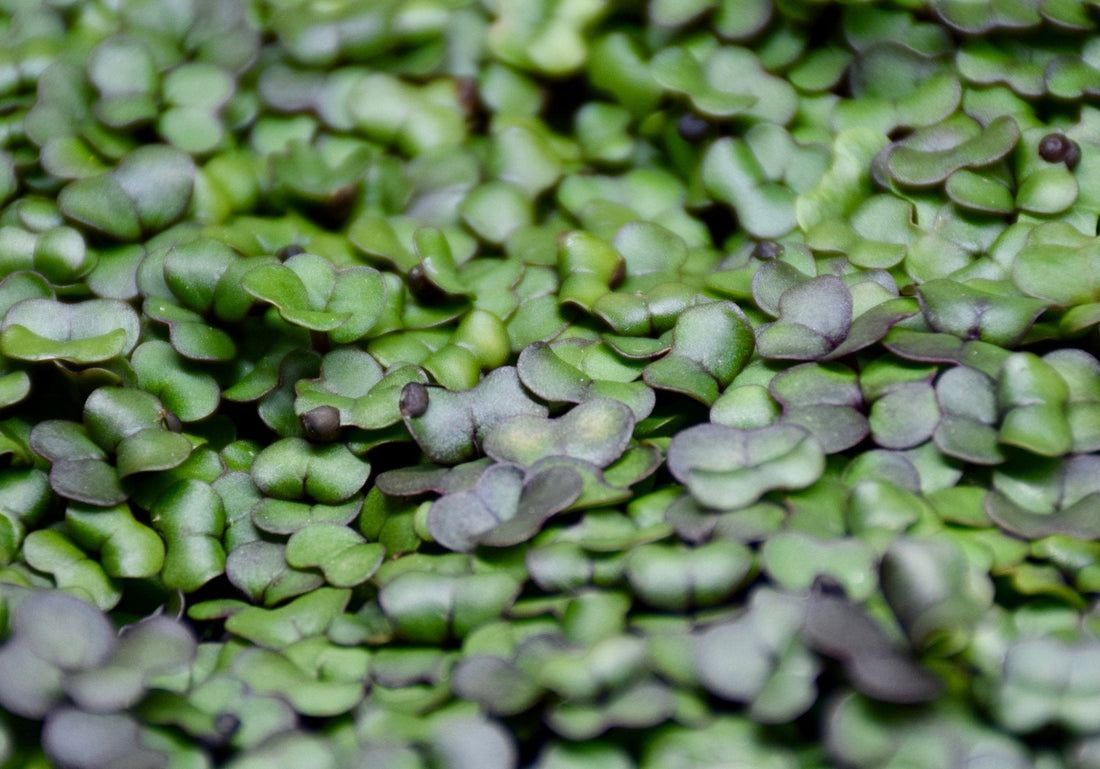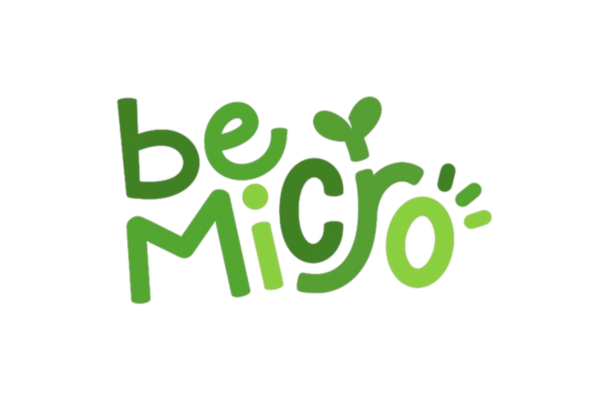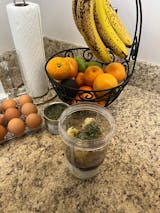
Science-Based Health Benefits of Sulforaphane
Share
What is sulforaphane?
Sulforaphane (pronounced 'sull-fore-uh-fane') is having a moment–and for good reason! More and more research is showing that the health benefits of sulforaphane are something to be excited about.
Sulforaphane has been shown to have a range of potential health benefits, like reducing weight gain, alleviating the symptoms of asthma, and systematically alleviating cell damage.
I know what you’re thinking now: how do I get more sulforaphane into my diet? Well, sulforaphane is unique to cruciferous vegetables like kale, broccoli, Brussels sprouts, bok choy and more, or check out this comprehensive list.
Otherwise, read on to discover all the benefits and learn some great ways to mix sulforaphane-containing foods into your diet.

Which foods contain sulforaphane?
Sulforaphane is unique to cruciferous vegetables. Cruciferous vegetables are found in the Brassicaceae family, also known as the mustard family. However, some Brassica vegetables make more of this potent compound than others.
If you’re trying to increase your intake of sulforaphane, focus on:
- Broccoli
- Cauliflower
- Kale
- Brussels sprouts
- Japanese daikon
- Bok choy
- Red cabbage
But if you’re trying to really maximize your intake of sulforaphane, try adding microgreens–baby vegetables–into your regular diet.
Broccoli and red cabbage microgreens in particular pack a major nutrient punch. These baby baby veggies have high levels of micronutrients and high levels of bioactives, such as the compound sulforaphane.
Amazingly, microgreens can contain many times the amount of micronutrients as their adult counterparts. For example, red cabbage microgreens have 40 times more vitamin E than adult red cabbage leaves! That means you can get more nutrition without having to eat more veggies overall.
What makes sulforaphane so unique?
Over the last decade, research on the health benefits of sulforaphane exploded. While many claims still need more research in humans, sulforaphane is one of the most potent health-boosting compounds available.
Sulforaphane can reduce viral load
The amount of viruses in a person's blood is called the 'viral load.' Viral load can tell us if someone's illness is getting better or getting worse. Sulforaphane has been shown to decrease viral load in human clinical trials. Viruses are tiny infections that replicate in living cells and can cause anything from a mild cough to death. The seasonal flu, for example, sickened more than 30 million Americans in 2019.
Sulforaphane has been shown to decrease flu virus in canine cells. It can also inhibit HIV-infection of macrophage cells. Sulforaphane has even been short-listed as a potential therapy for treating COVID-19.
RELATED: Nrf2 activators: What they are, and why you should be eating them!
Sulforaphane promotes healthier aging
As we get older, our metabolic processes get slower, we are less able to repair wounds and build muscle, we lose collagen throughout the body, and we start to accumulate oxidative damage. This is called aging.
Nrf2 production slows as we age so that the bad effects of free radicals start to build up. But some foods, plants and fungi in particular, have been show to decrease the effects of aging. Eating a diet rich in sulforaphane increases production of Nrf2 and promotes healthier aging.
Sulforaphane supports a healthier cardiovascular system
Cardiovascular health issues include heart attacks, strokes, and deep vein thrombosis. Sadly, 1 in 4 people in the United States die from cardiovascular diseases.
However, studies show that people who eat more cruciferous vegetables are less likely to die from heart disease. Sulforaphane specifically has been shown to protect against cardiovascular disease.

Eating brassicas can help protect the brain from age-related disease
Dementia is a word used to describe any kind of cognitive decline, while Alzheimer’s is a degenerative disease that causes poor connection between brain cells as well as brain cell death.
Studies in mice show sulforaphane prevented dementia in mice with Alzheimer's, while it’s also been shown to decrease beta amyloid proteins that create plaques in the brain. Plaques in the brain are a hallmark of Alzheimer's disease.
Sulforaphane can reduce weight gain without dieting
Sulforaphane can even reduce weight gain while eating a high-fat diet, such as the Standard American Diet which consists of processed foods, high-fat foods, red meat, refined grains, corn (including high-fructose corn syrup), and sugar.
Studies in mice show that sulforaphane can stop fat formation and reduce weight gain. The sulforaphane precursor glucoraphanin can also reduce the inflammation and oxidative stress caused by obesity.
Sulforaphane may be useful for improving glucose management
Diabetes is a disease that results in too much sugar in th blood. Keeping your blood glucose levels stable is a great way to manage the symptoms of diabetes.
In studies in humans, people with diabetes produced less glucose in their livers while taking concentrated sulforaphane supplements.
Cruciferous veggies can also protect and support healthy skin
Sulforaphane can protect skin against damage by UV radiation, as shown in mouse and human skin. Clinical trials are currently underway to find out if topical sulforaphane can also reduce skin aging.
Sulforaphane can also help improve brain function
Traumatic brain injuries can be difficult to heal. The brain has a powerful barrier against toxins and foreign compounds in the blood.
Fascinatingly, sulforaphane can help heal traumatic brain injuries. Sulforaphane helps to increase blood flow to the brain and reduce swelling, as well as activate Nrf2 pathways that reduce oxidative stress.
Increasing sulforaphane intake can reduce the effects of asthma
In one study in humans, 60% of people with asthma had reduced constriction of the airways. However, some people with asthma had worsening of effects, so more research is needed in humans.
May improve symptoms of autism
Autism is a disorder that causes repetitive behavior, problems with social interactions, and many other symptoms. For example, people with autism may have poor eye contact, perform repetitive movements, or be hyperactive.
Clinical trials in humans show that sulforaphane significantly improved social interaction, reduced abnormal behaviors, and improved communication. Some of the families in these studies even continued taking sulforaphane dosage after the trials were over, reporting improvement over a longer time period.
Sulforaphane can help reduce the effects of muscular dystrophy
Muscular dystrophy is a group of disorders that cause progressive muscle weakening and can cause death in severe cases. In a study of mice with muscular dystrophy, sulforaphane caused activation of the Nrf2 pathway which decreased muscle inflammation. In another mouse study, sulforaphane improved muscle function and reduced the oxidative stress on already-affected muscles.
How do I add sulforaphane to my diet?
Eating more cruciferous vegetables, raw or steamed, is one way to add more sulforaphane to your diet.
When you damage plant tissues–by cutting or chewing them, for example–an enzyme called myrosinase (pronounced 'my-roh-sin-ayze') can come into contact with the glucosinolates (pronounced 'gloo-koh-sin-oh-lates'). This contact converts the glucosinolates into isothiocyanates (pronounced 'iso-thyo-siyah-nates'), a group of powerful compounds. One of these compounds is sulforaphane. So you have to cut or chew the veggies to get the sulforaphane–but how you cook the vegetables also makes a difference.
Heat destroys enzymes, and sulforaphane needs enzymes to form. That’s why cruciferous vegetables should be eaten raw or only lightly cooked in order to maximize the health benefits of sulforaphane. That means no microwaving or boiling. Instead, steam for one to three minutes for the most sulforaphane. Learn the absolute best way to steam vegetables here!
Need some meal ideas? Try gently steaming chopped cauliflower as a side dish. Or replace the lettuce in your salad with broccoli microgreens. Red cabbage microgreens can make a colorful addition to avocado toast.
Want to easily max out your daily sulforaphane in three minutes? Check out this video that shows how gently heating broccoli microgreens can more than triple the sulforaphane content!
Carly Anderson Stewart, MSc | Head of Biology and Education
Featured Products
Dr. Abrar B
Learn MorePediatric physician with five years of experience in neonatology, NICU, PICU, and emergency care. Skilled in intubations and managing critical situations. As a medical author for BeMicro, focuses on nutrition for all ages, integrating evidence-based practices to improve overall health and well-being.










